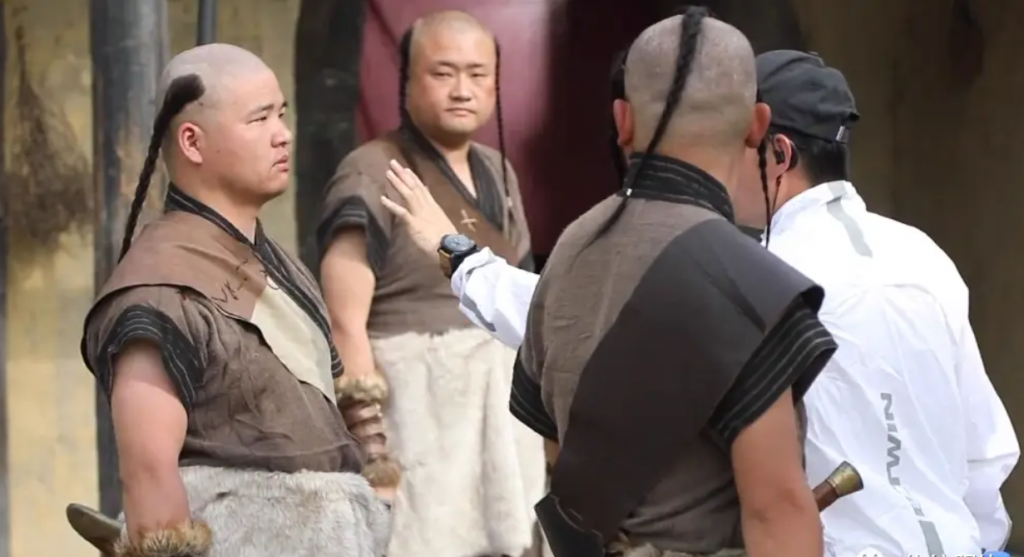When you think of ancient Chinese men, what comes to mind? Flowing robes? Graceful calligraphy? Perhaps an elegant topknot? Well, that topknot was not just a fashion statement—it was a cultural symbol that evolved over centuries, reflecting social status, ethnicity, and even political allegiance.
The Free-Spirited Beginnings: The Loose Hair Era
In the earliest days of Chinese civilization, men were free to let their hair down—literally. This style, known as “披发” (pīfà), or “loose hair,” was common because there were no rigid social norms dictating hairstyles. As civilization advanced, people realized that tying up their hair was more practical for daily work and gradually developed the habit of “绾髻” (wNJne jì)—tying hair into a bun on top of the head. At first, this was just a small knot, but over time, it became more elaborate, even resembling a cone shape, known as “锥髻” (zhuī jì).
Zhou Dynasty: The Birth of Hairstyle Etiquette
The Zhou Dynasty (1046–256 BCE) brought more than just Confucian ideals—it introduced strict hairstyle etiquette. Men were expected to bundle all their hair into a topknot and secure it with a hairpin (笄, jī). The elite would top this with a formal cap (冠, guān), while commoners would wrap their hair in a simple headcloth. Boys, on the other hand, were exempt from this rule and often sported braids or simply let their hair flow freely. Only upon reaching adulthood (usually at 20, though in folk tradition as early as 15) would they undergo the “冠礼” (guān lǐ) or “Crowning Ceremony,” signifying their transition into manhood.
The Half-Up, Half-Down Myth
Ever watched a Chinese period drama where the dashing male lead rocks a half-up, half-down hairstyle? Sorry to burst your bubble, but that wasn’t a thing—at least, not in mainstream Han Chinese culture. Leaving hair partially loose was considered a mark of “barbarians.” The only period when it briefly became fashionable was during the Northern and Southern Dynasties (420–589 CE) due to cultural exchanges with nomadic groups.
Tang & Song Dynasties: The Era of Headgear
During the Tang Dynasty (618–907 CE), men often wore “幞头” (fú tóu), a headpiece that looked like a soft cap. The Song Dynasty (960–1279 CE) took things further—Song Taizu (the first emperor) supposedly disliked court officials whispering to each other, so he mandated long, wing-like extensions on their headpieces. The result? Court sessions where officials had to maintain a respectful (and socially distant) stance to avoid awkward headpiece collisions.

The Great Haircut: Yuan Dynasty and the Rise of Shaved Heads
Enter the Yuan Dynasty (1271–1368), founded by the Mongols. Unlike the Han tradition of keeping hair intact, the Mongols practiced “髡发” (kūn fà)—shaving part of the head while keeping some sections braided. This was a drastic departure from previous norms, and even Korea (then under Yuan influence) adopted this style, with King Chungnyeol of Goryeo promoting it.

Ming Dynasty: Back to Tradition
With the fall of the Yuan and the rise of the Ming Dynasty (1368–1644), Han Chinese traditions were reinstated. Topknots made a triumphant return, restoring the “proper” way to wear one’s hair. But this was not to last.
The Manchu Takeover: The Queue as a Mark of Loyalty
The Qing Dynasty (1644–1912), ruled by the Manchus, enforced a strict hairstyle policy: Han men were required to shave the front part of their head and grow a long braid at the back—known as the “queue” (辫子, biàn zi). This was more than just a hairstyle—it was a political statement. To refuse was to defy the empire, leading to the infamous saying: “留发不留头,留头不留发” (Keep your hair and lose your head, or cut your hair and keep your head).

Hair Today, Gone Tomorrow: A Cultural Legacy
The Qing Dynasty’s forced queue policy ended with the fall of the empire in 1912, but the historical importance of hairstyles remains significant. Today, traditional hairstyles still appear in Chinese opera, martial arts performances, and period dramas (though with some historical inaccuracies—looking at you, half-up, half-down styles!).
From the free-flowing hair of early China to the disciplined topknots of the Zhou, and from the shaved foreheads of the Yuan to the long braids of the Qing, men’s hairstyles were never just about aesthetics. They symbolized cultural identity, social rank, and political allegiance. So next time you see a historical drama, take a closer look—you might just spot a piece of history on someone’s head.

No comments yet.